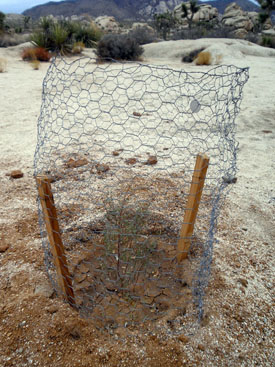
What’s with cage in the middle of desert?
TWENTYNINE PALMS, Calif. — My trip to Joshua Tree National Park in California was my first visit to a desert.
Although the fan palm oases were a wonder in and of themselves, I was truly surprised by all of the different and numerous plants that I saw in the area. Joshua trees of all different sizes covered a good amount of the sandy terrain, as well as other smaller desert bushes and cacti.
One of the things I found most interesting about all of this desert vegetation was the effort the park staff makes to protect the plants.
As I explored some of the campgrounds, I kept noticing tiny plants, some no taller than five inches, surrounded by a short metal fence. After a full day of wondering where these plants came from, I finally found a sign that answered my question: “What’s with the cage?”
| Joshua Tree National Park managers hope a small wire cage, such as this one at right, will protect young and fragile desert plants that are being placed throughout campgrounds (Photo by Kelsey Pinault). |  |
The park staff plants these young bushes and trees to “better delineate the space, to create more privacy for [the] campers, and to preserve the natural landscape.”
The sign also explained that the cages are meant to protect these young plants until they can survive on their own and to prevent any accidental disturbances to their growth.
With a park that covers more than 1,235 square miles, I find it amazing that staff and volunteers find the time and have the dedication to do this. The chief of Interpretation at the park, Ranger Joe Zarki, explained to me that when any construction is done or areas with foliage are disturbed, they will carefully remove the plants in the area and attempt to replant them to restore the natural landscape when the area is safe again.
“We have a plant nursery here to grow plants that are native to the park. Whenever there is damage from ecological restoration or construction, we go the extra mile to dig and box up the plants so we can help them recover,” Zarki told me.
This place is more than just a park to the people who work and volunteer here. The staff’s passion in keeping every part of Joshua Tree at its best as well as providing amazing amounts of knowledge of the area, made my experience truly memorable.
Throughout my trip I gained an entirely new perspective of this national park and it all started with a little tree in a cage.
Kelsey Pinault ‘12
University of Miami

Comments are Closed